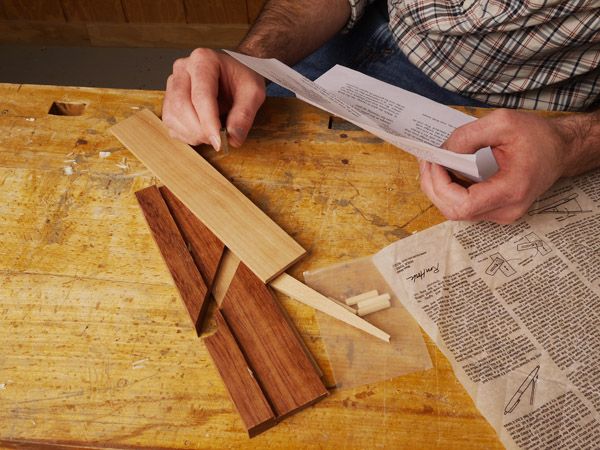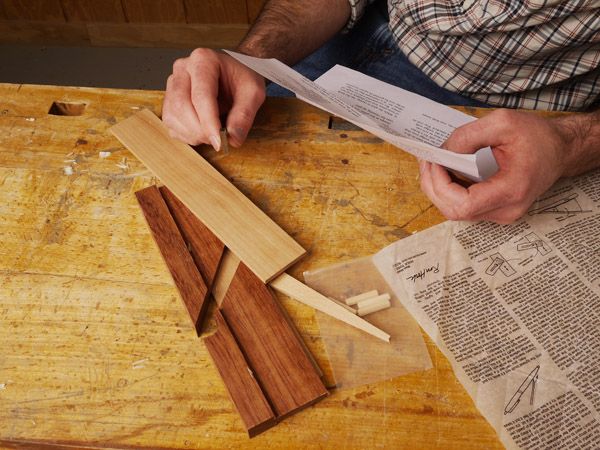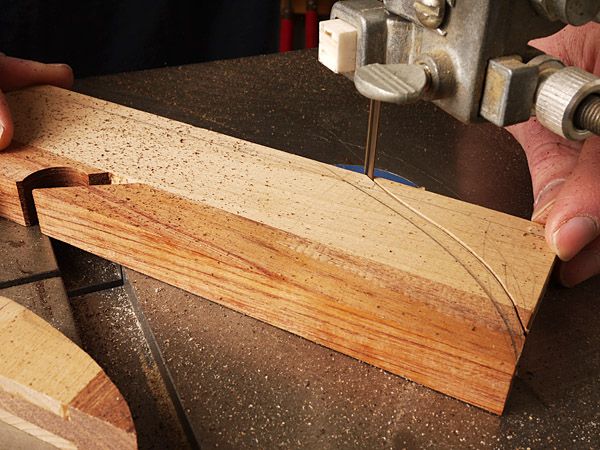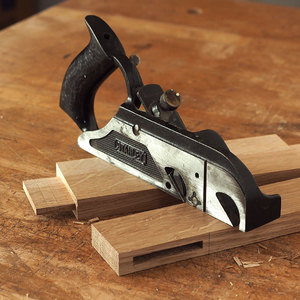Build Your Own Shoulder Plane: Does this Kit Pass the Test?

Instructions that are easy to follow! Not only that, the blade comes wrapped in a piece of paper that some great sharpening instructions on them.
I like to make tools, but I don’t make them just for fun. Typically, I only make one when I can’t find what I want out in the land of commerce (like these planes or this marking gauge). However, when I saw that Hock Tools now sells a shoulder plane kit, I thought I’d give it a try. Part of what drove my decision was curiosity. I’ve made hand planes of my own design and I wanted to see how someone else does it. I’ve also been contemplating the possibility of making a rabbet plane, which isn’t too far off from a shoulder plane, so I thought Hock’s plane might give me some good ideas. I was also drawn to its price. At $90, it’s about half the cost of a new metal bodied shoulder plane from Lie-Nielsen, Veritas, and Clifton (comparing 3/4 in. models). There was a point (I’ve only barely gotten past it) when I couldn’t afford tools and I wanted to know if the Hock plane was a viable option for others in that position. Well, now that you know why I decided to give it a try, let’s get on with my review.
I’ll start with building the plane, because, well, I started with building the plane. There are only three parts to be glued up: two beech sides and a piece of jatoba (aka, Brazilian cherry) that does double duty as the sole and the bed and throat (NOTE: I was wrong about the wood species. It’s bubinga, not jatoba. And there are 4 pieces of wood, not three. The bubinga is cut into two pieces. One make the bed, the other the front of the throat). Putting them all together couldn’t be easier. Line up the parts, clamp or tape them together, drill four holes for alignment pins, and then glue it together. I did have one problem with the glue-up. Both of the beech sides in my kit were slightly cupped, not surprising given that these parts came across the entire country to get from California to Connecticut. I don’t really have a problem with it (hey, wood moves), but I do give you this warning. Before you glue up the parts, make sure you’ll be able to remove any cupping with clamping pressure. If you can’t you should give Hock Tools a call and talk about your options. You want those glue joints to be nice and tight, because the parts are pretty much at final dimensions. That means that if you remove any thickness from the sides to make them flat, you’ll probably have to grind the blade down too. (The width of a shoulder plane blade should be equal to the body’s thickness.)
As with all wooden planes, adjusting the blade depth is a delicate dance. It’s one that some folks glide through like Fred Astair, but which others execute with all the grace of a drunken fraternity brother. I’m somewhere in between. The more I use my little grooving planes, the better I get at setting the blades. But it’s still a bigger hassle than setting blade depth on my metal body shoulder plane.After the glue dried, I shaped it, trued the sole, opened the mouth a bit, and sharpened the blade. Then I put it to use. The plane does its job. Because it’s a bevel down blade, it handles long grain well, so you can trim grooves and rabbets. But the iron is bedded low enough (37 1/2 degrees) to handle end grain without trouble. I do have one complaint. I think the plane needs a bigger opening for shavings to escape through. My plane’s throat tends to get clogged, and it’s tough to get a finger in there and pull them out. A slightly bigger opening would solve the first problem, and I wouldn’t need to worry about my finger getting in there. Now, I’m the type of guy who is not afraid to modify a tool, and I’ll enlarge the opening myself. I suppose you could count that as part of the fine tuning that needs to be done to get the plane working great, but I’d rather not have to do it.
In the end, the plane is a great value. With a little bit of sweat equity you get a shoulder plane that works well and that’s a fair trade to save close to $100.
A big note about shaping the plane: I strongly recommend that you mill up some scrap to the same size as the shoulder plane and test out shapes on it. You want the plane to be comfortable to hold and that shape you think looks cool may not be comfortable.
More on Homemade Tools
• Interview: Plane Maker Steve Knight
• Homemade Horizontal Router Table
• Build-Your-Own Power Tool Plans
• How to Make a Scratch Stock ![]()























Comments
What a rip. $90 for a piece of metal and 3 scraps of wood? I don't think so.
cousinchas,
I'm sorry I wasn't clearer in my post. I actually didn't get 3 scraps of wood and piece of metal from Hock Tools. The kit comes with a blade that has been shaped and heat treated properly, not a "piece of metal". (Shoulder plane blades have a unique shape and its not one that can be easily duplicated without metal working machinery.) There are actually 4 pieces of wood in the kit, but I wouldn't describe them as scrap. The 2 pieces of Jatoba, for example, have a unique shape that would be a pain to mill accurately in the average shop. What I'm pointing out is that $90 buys more than a piece of metal and some wood scrap.
Matt,
"She's a real beaut, ain't she Clark."
It's hard to tell, but in the last pic it looks like you've put a light chamfer on the long edges of the sole?? If so, does that hinder your iron adjustment at all; only from the standpoint of setting depth & side-to-side, etc...? I suppose you could just use the bed to adjust laterally, and make test cuts for depth.
I ordered some radiused Hock irons and made a pair of (1 1/4" & 1 1/2") coopering planes. I also have two Hock irons in my old Stanley #'s 4 & 7. As you wrote, they are certainly more than "pieces of metal."
Paz, Jarrod
I agree with the last comment at $90 is a bit high. I purchased mine after getting a great coupon and paid around $70. I am slowly getting into hand tools due the cost and I felt this was a great option to get Hock quality and it takes the guess work out of the machining the parts. I sharpened it to 30degs as recommend from Hock and put a micro-bevel at 35deg. It really purrs, I could not be happier. This kit is perfect for someone who has woodworking experience, but minimal experience making tools. It has given me the confidence going forward to make my own tools.
Jarrod,
I did not chamfer the edges. I think that's just a trick of the lights.
Matt
I had a look at the cost of the individual items and $90.00 looks good.
OK, so its a shaped piece of tool steel... that Hock sells as a replacement blade for $28. That leaves $62 for the wood (which you admiitted was warped). I can buy a lot of exotic hardwood for $62 and mill it myself. It is just a couple of angled cuts a curved mouth which could be drilled out with a Forstner bit.
By the way, I watched Hock's assembly video and the blade back isn't even ground flat. You have to do it yourself.
I guess I'm just more of a tightwad that ya'll. I expect more for my money.
Listen, I'm defending the price. I'm just pointing out that there is more to it than you suggested. And if you really want to be fair to Hock Tools, make sure you factor in the cost of the time you spend buying, milling, and otherwise working the wood to get to the point they do. The cost of anything involves more than just the cost of the raw material. There is the labor, too. That's part of the reason a tool made overseas can cost much less than the same tool made here in the US.
Check that, I meant to say I'm not defending the price.
Well, I am defending the price. Those of us who don't have the funds for a nice shoulder plane most likely don't have the resources(tools) to make this out of scrap.
Matt,
Good point about factoring in all the costs for doing it yourself. The guy that thinks he can make those four little parts from some exotic wood quick and cheap is probably also the one selling his projects for material cost only thereby undercutting the people that price things correctly. Looks like a great plane but I'll spend the extra and buy the finished version, time is money to me.
Bob
Matt,
Can you tell me how the Hock bevel down plane compares to a bevel up version? I've been looking at shoulder planes for a while, and most of the others I've seen are bevel up. Let me know if there is a significant difference.
John
John,
It all comes down to the cutting angle. The two most popular bevel-up metal body shoulder planes (LN and LV) have cutting angles of 43 and 40 degrees respectively. The Hock plane is bevel-down, but is bedded at 37 1/2 degrees, so it's cutting angle is 37 1/2 degrees. That's almost 5 degrees lower than the LN! That surprised me when I first did the comparison. In theory the Hock should handle end grain better because of its lower angle. However, a bevel-up plane works (at least in theory) end grain a bit better. Based on experience--I've used all three--there isn't a bad choice among them. I'd say let ergonomics, ease of use, etc. be you deciding factor.
-Matt
Hey, nice looking plane! Great weekend project!
Matt, Can you give me your opinion on how practical it might be to modify the Hock kit into a moulding plane? I've been unsuccessful in my search for a moulding plane matching a specific profile for a window sash meeting rail.
Benito9,
I wouldn't try to modify the Hock shoulder plane. You'd have to grind the blade and modify the body. By the time you've done that, you've essentially done all of the work you would have done to make one yourself. However, you don't need to go old school to make a molding plane. The style that Clark & Williams make are very nice, but also tough to make. Instead, make one using the building technique made popular by James Krenov. David Finck recently did an article explaining how to make a smoothing plane that way (in FWW #196, "Wooden Planes Made Easy"). I've used that technique to make molding style planes. It works. You can use the iron blanks sold by Lie-Nielsen.
Matt
While I have not done the Hock Shoulder Plane, I have done a couple of his other kits and I have done several Krenov style planes from "skratch". I presented a Mentor Workshop on making wooden bodied hand planes and told the members that they could start with a kit or their own wooden pieces but the key was a good blade, a good bed, and a flat sole. I still use metal body planes but I most often find myself reaching for one of the wooden beauties. I would never classify any of Ron Hock's products as a "rip".
Log in or create an account to post a comment.
Sign up Log in